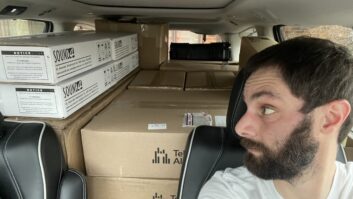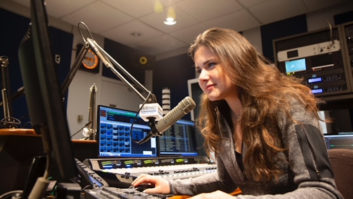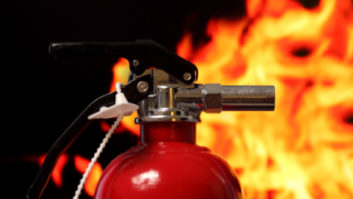
Al waits for Michael J. Fox to appear.
One fun thing about New York: you’re never more than a few steps away from some familiar sight or scene from your favorite movies or TV shows. If you’re a fan of the new “Michael J. Fox Show,” then you’ll recognize the 72nd Street subway station at Verdi Park from the opening credits. That’s me looking like some grizzled old Kentucky colonel, ruining the picture!
Went to a great workshop on Saturday, “Technology & Storytelling: How Can We Best Use the Tools Available to Tell Our Stories?” David Shinn and Sue Zizza of SueMedia Productions, Carle Place, N.Y., moderated this session, talking about microphone choices, sound effects and digital editing along with mixing to accomplish high-quality spoken-word recordings. While geared towards multimedia and talking books, there was plenty here for any radio production person. Think you sound good on your RE20s? Two voice actors read lines into four different microphones, and the difference was more than evident. Mic selection truly is important, given the material, the announcer’s timbre and the mood of the recording.
If you’re still trucking around with the same ratty headphones you’ve had since you got in the business, these Extreme Isolation EX-29 headphones are worth a listen. The sealed cups knock 29 dB off external sounds (hence the name “EX-29”), so no more feedback around an open microphone. All components are replaceable when worn out, so it will be with you for the next dozen years or so.
There was a 1:30 workshop on maintenance and repair of audio equipment that I put on my dance card because I hate throwing out gear I know to still be good.
I guess I was expecting something different when I went in to the “Maintenance, Troubleshooting and Repair” session on Saturday afternoon. In my head, I was focused on how to field-repair a stubborn mixer or clear a fussy ISDN codec just in time to hit the remote broadcast. But what I came away with surpassed my expectations and made me glad I came.
John Bisset, Radio World’s Workbench editor and a salesman for The Telos Alliance, along with Bill and Kimberly Sacks (Optimod Refurbishing, Hollywood, Md.) took on those relevant issues when benching a piece of nonfunctioning gear — how to find that one bad component, how to check for the “Pin 1 Problem,” what it takes to fix up a surface-mount PC board, all of that. As an engineer for a talk radio network tasked with the repair of studio components, I am frequently tempted to just pitch a piece that seems too troublesome or impossible to repair, even though I know the repair would be effective. Kimberly, Bill and John reinvigorated something in me to go through that shelf of bad gear (including a couple of Instant Replays) and get a lot of it back into service.

Al likes these Extreme Isolation EX-29 headphones.
They also shared a cool trick to “brighten” up the sound of older gear with a couple of film capacitors. But if you want to know it, you’ll have to come to the next conference.
Sunday was my last opportunity to walk the product floor before AES folds the tents and takes off for Berlin, Germany (the 136th conference in April).
Now and again in the fancy, frilly world of sparkly new audio tools, one little offbeat item stops you and makes you go, “Okay, now that’s different.”
Such is the case of the Miktek “ProCast” — a simple little box the company rolled out during Summer NAMM. It is almost toy-like in its appearance, but is a remarkably handy device dedicated for podcasting. The ProCast is a two-channel line/mic mixer with phantom power, internal soundcard and a built-in boom microphone that connects via USB to a laptop computer. You can devote Channel 1 to the mic and Channel 2 to another mic or line input from an iPod or other audio device. Log in to your streaming service, hit the mic and you’re on the air.
For podcasters now obligated to bring a simple mixer, mics and a USB interface, this one-piece solution is pretty nifty. Of interest to broadcasters, this is a wonderful solution if you are using Skype or another VoIP service to do remote broadcasts. The ProCast has a mix knob that lets you hear foldback from the studio end. Time cues and music roll-ins can be heard by the talent, just as if you were using a more expensive portable codec.
I saw some great new mics from Neumann and a killer monitor speaker from Genelec.
UPDATED:

Al is Mesmerized by Lawo’s new radio broadcast console.
Where do convention goers head to when the floor closes? I wondered that myself. Lots of folks go to parties thrown by the companies exhibiting their wares, some take in concerts, clubs or theater.
Some enjoy a quieter more dignified diversion.
I headed uptown to Central Park West to visit “Strawberry Fields” — the John Lennon Memorial at 72nd Street inside the park. From my bench, I watched a lot of faces I saw at the Javits Center stop at the “Imagine” mosaic, taking selfies and just talking shop. A musician with a slide resonator guitar sat nearby, quietly picking out Beatles tunes and some of Lennon’s solo pieces in a simple tribute. John’s been gone 33 years this December, and here are audio pros and students not yet 30 years of age themselves taking the moment to heart. Quite nice.
Just when I thought radio was a forgotten audio discipline, the company Lawo showed up on the exhibit floor with a new mixer-controller dedicated to radio broadcast. That’s me looking over the control surface. Very nice, and dig that itty-bitty Gefell microphone.
Word has it that Lawo is about to take on a major studio refit over the next two years for a very large and significant broadcaster, with a purchase that could mean a hundred of these consoles. That is going to be interesting.
Bock Audio Designs 507

Click on the Image to Enlarge
On the topic of microphones, some huge buzz was happening over the newest Neumann to hit the street: the TLM 107. By the company’s own description, the 107 is appropriate for percussion and the “finest overtones of stringed instruments,” with minor mention of voice. But a Neumann is a Neumann is a Neumann, and I’m more than excited to give it a ride around the block. I’ll let you know if they send me one to try out.
One name I hadn’t associated with broadcast mics is Bock Audio Designs, known as a high-end studio tube condenser mic designer. However, I ran into Robert Fass, a voice talent whom I saw in a session on Saturday, and he said I should take a look at the company’s 507. Well, I did and it is. Bock Audio microphones have a decidedly German look to them (and a handmade German capsule to boot), but are all hand-assembled here in the U.S., only 5–10 at a time. If a pro voiceover guy says it’s worth a look who am I to argue? This is very much another mic I want to see when one comes up for air.
Genelec monitors can be found in production rooms everywhere. But what about when you need a big moose of a monitor to take in the whole mix, not just nitpick at the up-close details? The 1238A monitor had it in spades: 500 W low-frequency speaker, 250 W in the mids and 200 W in the highs. And this monitor automatically tunes itself to your room so you always get a matched response between the speaker and the room you are in. When you have no time to throw together a mix to be on the air “in the next 10 minutes,” you have to hear it right.
The AES show is, by nature, a convention for all audio disciplines, and radio has its own trade show to strut its stuff. But sort through all the gee-whiz and wowee products on the AES exhibit floor and there is plenty to get the attention of the dedicated radio professional. Very shortly, you can read my product summary in an upcoming issue of Radio World. In the meantime, thanks for coming along for the ride.





